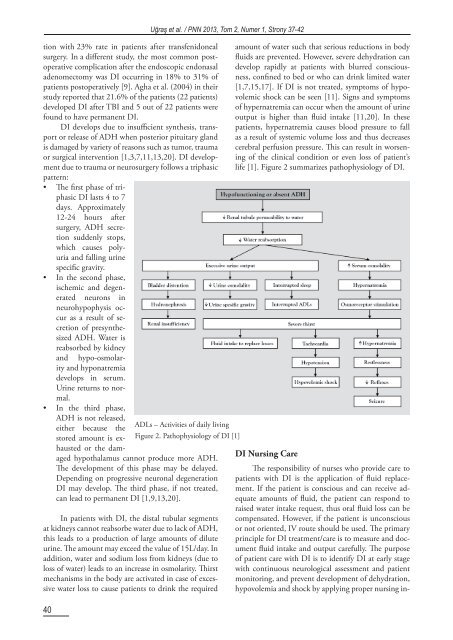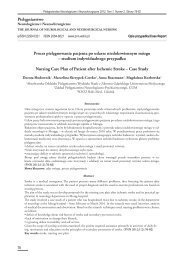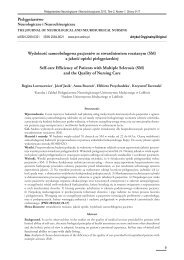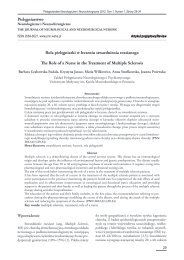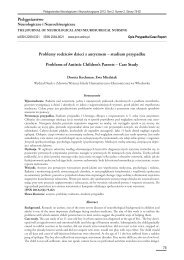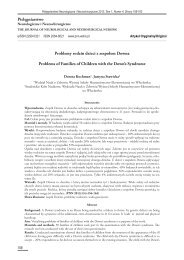1 - PNN - Wyższa SzkoÅa Humanistyczno-Ekonomiczna
1 - PNN - Wyższa SzkoÅa Humanistyczno-Ekonomiczna
1 - PNN - Wyższa SzkoÅa Humanistyczno-Ekonomiczna
Create successful ePaper yourself
Turn your PDF publications into a flip-book with our unique Google optimized e-Paper software.
40<br />
Uğraş et al. / <strong>PNN</strong> 2013, Tom 2, Numer 1, Strony 37-42<br />
tion with 23% rate in patients after transfenidoneal<br />
surgery. In a different study, the most common postoperative<br />
complication after the endoscopic endonasal<br />
adenomectomy was DI occurring in 18% to 31% of<br />
patients postoperatively [9]. Agha et al. (2004) in their<br />
study reported that 21.6% of the patients (22 patients)<br />
developed DI after TBI and 5 out of 22 patients were<br />
found to have permanent DI.<br />
DI develops due to insufficient synthesis, transport<br />
or release of ADH when posterior pituitary gland<br />
is damaged by variety of reasons such as tumor, trauma<br />
or surgical intervention [1,3,7,11,13,20]. DI development<br />
due to trauma or neurosurgery follows a triphasic<br />
pattern:<br />
• The first phase of triphasic<br />
DI lasts 4 to 7<br />
days. Approximately<br />
12-24 hours after<br />
surgery, ADH secretion<br />
suddenly stops,<br />
which causes polyuria<br />
and falling urine<br />
specific gravity.<br />
• In the second phase,<br />
ischemic and degenerated<br />
neurons in<br />
neurohypophysis occur<br />
as a result of secretion<br />
of presynthesized<br />
ADH. Water is<br />
reabsorbed by kidney<br />
and hypo-osmolarity<br />
and hyponatremia<br />
develops in serum.<br />
Urine returns to normal.<br />
• In the third phase,<br />
ADH is not released,<br />
either because the<br />
ADLs – Activities of daily living<br />
stored amount is exhausted<br />
or the dam-<br />
Figure 2. Pathophysiology of DI [1]<br />
aged hypothalamus cannot produce more ADH.<br />
The development of this phase may be delayed.<br />
Depending on progressive neuronal degeneration<br />
DI may develop. The third phase, if not treated,<br />
can lead to permanent DI [1,9,13,20].<br />
In patients with DI, the distal tubular segments<br />
at kidneys cannot reabsorbe water due to lack of ADH,<br />
this leads to a production of large amounts of dilute<br />
urine. The amount may exceed the value of 15L/day. In<br />
addition, water and sodium loss from kidneys (due to<br />
loss of water) leads to an increase in osmolarity. Thirst<br />
mechanisms in the body are activated in case of excessive<br />
water loss to cause patients to drink the required<br />
amount of water such that serious reductions in body<br />
fluids are prevented. However, severe dehydration can<br />
develop rapidly at patients with blurred consciousness,<br />
confined to bed or who can drink limited water<br />
[1,7,15,17]. If DI is not treated, symptoms of hypovolemic<br />
shock can be seen [11]. Signs and symptoms<br />
of hypernatremia can occur when the amount of urine<br />
output is higher than fluid intake [11,20]. In these<br />
patients, hypernatremia causes blood pressure to fall<br />
as a result of systemic volume loss and thus decreases<br />
cerebral perfusion pressure. This can result in worsening<br />
of the clinical condition or even loss of patient’s<br />
life [1]. Figure 2 summarizes pathophysiology of DI.<br />
DI Nursing Care<br />
The responsibility of nurses who provide care to<br />
patients with DI is the application of fluid replacement.<br />
If the patient is conscious and can receive adequate<br />
amounts of fluid, the patient can respond to<br />
raised water intake request, thus oral fluid loss can be<br />
compensated. However, if the patient is unconscious<br />
or not oriented, IV route should be used. The primary<br />
principle for DI treatment/care is to measure and document<br />
fluid intake and output carefully. The purpose<br />
of patient care with DI is to identify DI at early stage<br />
with continuous neurological assessment and patient<br />
monitoring, and prevent development of dehydration,<br />
hypovolemia and shock by applying proper nursing in-


